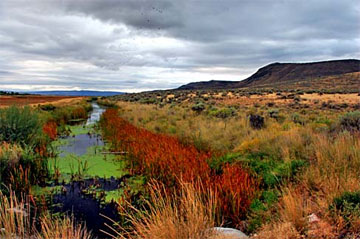17 January 2016

The seizure of Malheur National Wildlife Refuge (NWR) in Oregon by a group of armed occupiers has been a major news event since it began at the start of January. We would have hoped that by now the confrontation would be over, resolved in a peaceful fashion, with the armed insurrectionists gone and the refuge back to fulfilling its role managing the land for wildlife and making this natural treasure accessible to the American public.
No such luck.
Instead, the drama continues; the occupiers are emboldened; the locals’ wishes are ignored, and the American public is locked out.
This is a great disappointment and a great injustice. These outlaws are keeping the American people from enjoying the refuge and are keeping land managers and professional conservationists from doing important work. That work means appropriately caring for the resource, to benefit wildlife and the public, for today and tomorrow.
This seizure is not what visionary conservationists would have imagined 108 years ago when they convinced President Theodore Roosevelt to establish the refuge. Today, the 187,000+-acre refuge accounts for some of the most important bird and wildlife habitat in the region and on the Pacific Flyway. In fact, Malheur also represents a classic success story in the area of true cooperation and regional consensus-building. In 2013, the refuge adopted a long-term management plan (Comprehensive Conservation Plan) through a creative and inclusive process that brought together local communities, hunting and conservation groups, tribes, government entities, and other stakeholders to hammer out a strategy for wise management, neighborly-interests, and serious wetland restoration.
If these lawless out-of-state occupiers wanted to seize a federal property that represented bad management and the dismissal of local interests, they actually picked the wrong place.
Unfortunately, much of the background on the refuge, its purpose, its origin and growth, and its conservation value are being lost in the commotion. Sometimes, the media confuses the national wildlife refuge with federal BLM lands or even national parks.
This is of some concern to the Friends of the Migratory Bird/Duck Stamp. The role of the Migratory Bird Hunting and Conservation Stamp, often called the Duck Stamp, has been instrumental in securing some of the most valuable habitat at Malheur NWR. A major portion of the refuge was acquired through investment of Duck Stamp dollars, put into the federal Migratory Bird Conservation Fund (MBCF). About 48,000 of the current 187,000+ acres of the refuge have been secured via MBCF/Stamp dollars, through willing sellers. That’s just over a quarter (25.8%) of the refuge.
This means that those millions of Americans who have bought the Duck Stamp in the past or today – be they waterfowl or other hunters, birdwatchers, stamp collectors, anglers, wildlife photographers, environmental educators, refuge friends group members, or others – have either already played a role in securing Malheur or have a special and personal stake in making sure that their current “investment,” through the stamp, is secure.
Today, the seizure at Malheur presents a challenge to the very concept of government land-stewardship in America, and it is an attack on our natural heritage and on open access to our lands.
Simply put, attempts to seize any part of the refuge system are attempts to take property away from the American people. That effort is not simply the agenda of a small group of armed extremists. In the past few years, state and federal lawmakers across the American West have proposed laws to take over federal lands inside their states. Instead of making federal land management smarter, these misbegotten efforts undermine the conservation-and-access rationale for these lands, be they national wildlife refuges, forests, parks, or BLM lands. Such moves could ultimately put priceless landscapes on the auction block, sold off with some weak justification linked to “deficit reduction.” The extremists in Oregon, in fact, may be creating the political and social space for these sorts of proposals to sound more “reasonable.”
Back in Oregon, the brazen land grab must be brought to a close, safely and quickly. The illegal occupation needs to end, and the armed occupiers should be brought to justice. Most importantly, however, the case needs to be made to the American public over how these treasured landscapes got to be secured for the American public in the first place, including the role of the Duck Stamp, and why modern conservation management of our federal lands is so vital for Americans today and for those Americans who will follow us.